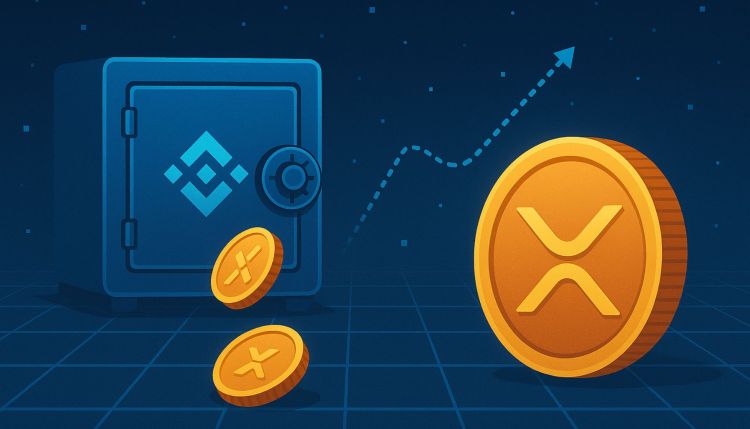XRP Reserves On Binance Collapse To Record Lows: Investors Move Toward Long-Term Holding

Analysis
Price Impact
HighRecord-low xrp reserves on binance and consistent outflows to self-custody wallets, coupled with the launch of us spot xrp etfs, indicate a significant shift towards long-term holding and institutional interest, creating a potential supply squeeze.
Trustworthiness
HighThe source explicitly states a strict editorial policy focused on accuracy, relevance, and impartiality, with content created by industry experts and meticulously reviewed, adhering to the highest reporting standards.
Price Direction
BullishWhile xrp currently faces short-term selling pressure and volatility, the underlying trend of substantial exchange outflows and institutional product adoption (etfs) signals strong long-term accumulation and increasing investor confidence, which is fundamentally bullish for future price appreciation.
Time Effect
LongThe shift of xrp from exchanges to private wallets for self-custody and the entry of institutional etfs are strategic moves indicating a long-term accumulation phase by holders and institutions, positioning for sustained growth rather than short-term speculation.
Original Article:
Article Content:
Reason to trust Strict editorial policy that focuses on accuracy, relevance, and impartiality Created by industry experts and meticulously reviewed The highest standards in reporting and publishing How Our News is Made Strict editorial policy that focuses on accuracy, relevance, and impartiality Ad discliamer Morbi pretium leo et nisl aliquam mollis. Quisque arcu lorem, ultricies quis pellentesque nec, ullamcorper eu odio. XRP is under intense selling pressure as the broader crypto market enters a decisive stage marked by fear, uncertainty, and a rapid shift in investor sentiment. With Bitcoin struggling to recover and altcoins posting steep losses, many analysts are warning that XRP could face a continued decline in the coming days. Investors are bracing for more volatility as liquidity thins and market confidence weakens. Related Reading Major Bitcoin LTH Sell-Off Signals Cycle Exhaustion as Supply Drops to 13.6M BTC 20 hours ago Yet, despite the bearish narrative, the XRP ecosystem has shown unusual levels of activity—particularly on the institutional front. The arrival of the first US spot XRP ETFs has reshaped its market profile. Canary Capital was the first to launch on November 13, soon followed by Franklin Templeton, Bitwise, and Grayscale. In a matter of days, XRP transitioned from a conventional crypto asset to one accessible through regulated institutional vehicles, potentially shifting its long-term demand dynamics. This new backdrop makes one ongoing trend on Binance even more striking. Since October, XRP reserves on the exchange have been falling sharply. Current data shows reserves have dropped to roughly 2.7 billion XRP, one of the lowest levels ever recorded on the platform. Such consistent outflows signal rising demand for self-custody—an important metric as XRP navigates this critical market phase. XRP Exchange Outflows Signal Strengthening Long-Term Demand According to a new CryptoQuant report by analyst Darkfost, XRP is experiencing one of its most notable exchange outflow trends in years. Since October 6, roughly 300 million XRP have left Binance alone—a figure far too large and too consistent to dismiss as simple internal reshuffling. While a small portion of these transfers may be operational movements by the exchange, the broader pattern is unmistakable: investors are steadily withdrawing XRP from trading platforms. XRP Ledger Exchange Reserve on Binance | Source: CryptoQuant This behavior is typically interpreted as a bullish long-term signal. Day after day, the decline in exchange reserves continues, suggesting that buyers are choosing to move their XRP into private wallets rather than leaving them on exchanges for trading or short-term speculation. Historically, large-scale withdrawals reflect strong conviction, as holders position themselves for longer-term appreciation rather than immediate selling. The supply dynamics created by this trend are significant. With fewer tokens available on exchanges, liquidity tightens. When combined with the rising institutional interest brought by newly launched U.S. spot ETFs, this creates the potential foundation for a powerful shift in momentum. If exchange reserves continue dropping at the current pace, XRP could enter a more structured phase of accumulation—one driven not by hype, but by growing confidence from both retail and institutional participants. Related Reading Ethereum ICO Whale Sells 20,000 ETH ($58M), Raising Questions Over Market Timing 22 hours ago XRP Attempts to Stabilize but Remains Under Strong Selling Pressure XRP’s recent price action on the 3D chart shows an asset trying to stabilize, yet still struggling against a clearly bearish backdrop. After weeks of decline, XRP found temporary support near the $2 psychological zone, where buyers briefly stepped in to prevent a deeper breakdown. This area aligns closely with the 200-day moving average (red line), which has acted as a final line of defense during multiple market cycles. XRP testing key resistance | Source: XRPUSDT chart on TradingView Despite the small rebound, XRP continues to trade well below the 50-day and 100-day moving averages, both of which are now sloping downward and reinforcing the broader bearish trend. The inability to reclaim the $2.40–$2.50 zone — an important previous support turned resistance — suggests that sellers still dominate the market structure. Volume also remains muted compared to earlier phases of the cycle, indicating that strong conviction buying has not yet returned. Related Reading Bitcoin Short Squeeze Flushes Out Late Longers as Funding Turns Negative: Classic Capitulation Signal 1 day ago The wick-down capitulation move seen earlier in the month reflects aggressive liquidation, followed by a rapid recovery. While this type of price action can sometimes precede short-term relief rallies, the overall pattern still leans bearish unless XRP can break above key moving averages. Featured image from ChatGPT, chart from TradingView.com